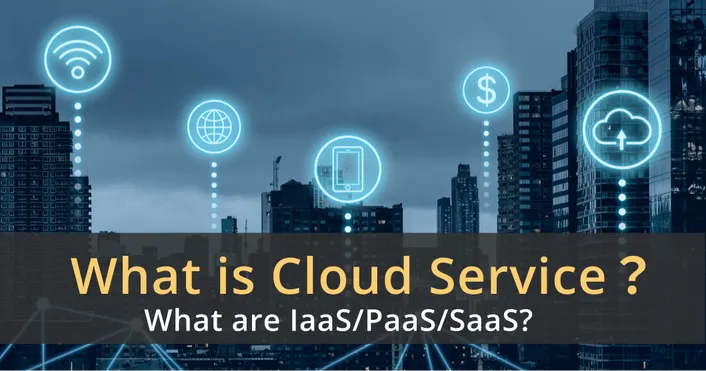What is Cloud Service? A Quick Guide to The Three Major Deployment Models.

Are you interested in learning about setting up a platform for self-entrepreneurship, or the conversion characteristics brought by online marketing? Our cloud service system is suitable for small and medium-sized enterprises. With convenient online payment and data integration, you can quickly improve natural website traffic and tap into potential customers, creating a fully automated marketing model for your business! Hearing this, you may wonder what exactly is the cloud? What are the modes of cloud services? How should enterprises use cloud services? Read on with us.
3 Major Models of Cloud Services
IaaS(Infrastructure as a Service):
"IaaS" refers to online services that specialize in handling large data, such as online servers and virtual spaces. Essentially, it includes three types of services: "computing power," "storage space," and "network resources." In the past, to enjoy these services, users usually had to spend a large sum of money to set up servers, develop programs, build computer rooms, and hire program developers and equipment maintenance engineers. However, with IaaS, users can easily access these services through the internet, which is both economical and safe. Common IaaS cloud service platforms include Microud by Cherrypicks, AWS by Amazon, and GCP by Google.
PaaS(Platform as a Service):
"PaaS" refers to providing execution or development environments to enable users to develop, test, and manage applications. This solves the difficulty of early system development teams needing to adjust many complex settings, allowing developers to more efficiently build applications. The main targets are users who have programming skills and are usually a company's system development team. Classic PaaS cloud service examples include Google's App Engine or Microsoft's App Service.
SaaS (Software as a Service):
"SaaS" provides cloud services that allow users to not have to install applications on their own computers. Instead, the software is rented to users through the internet as a revenue-generating business model, and the plan can be adjusted according to usage needs, which is both affordable and flexible. Users only need to know how to use the application and do not need to purchase hardware equipment, write code themselves, or maintain and update the application, greatly reducing the entry barrier. Examples of SaaS in our daily lives include Gmail, Office365, Microud's international SMS platform AboSEND, and voice platform AboTALK.
Comparison Table of the Three Cloud Service Models
| IaaS | PaaS | SaaS | |
|---|---|---|---|
| Definition | Provide computing hardware facilities through the Cloud Service | Provide system development environment through the Cloud Service | Provide applications through the Cloud Service |
| Merits | No need to purchase physical equipment or hire maintenance personnel, and can use relevant hardware resources by itself | No need to worry about the operating system and environment for developing programs, and can concentrate on developing programs | No need to develop, update, and maintain applications by yourself, and can enjoy application resources |
| Application cases | Microud AWS GCP | App Engine App Service | Gmail AboSEND Office365 |
eployment Methods for Cloud Services
Public Cloud
Public cloud is built by third-party cloud service providers (such as Google, Azure, AWS, etc.), providing an open resource space on the internet. Its target audience is mainly general consumers or small and medium-sized enterprises, so it is the best entry-level cloud host. For example, Google Apps or Microsoft Office 365 mentioned above use the public cloud's cloud service model, sharing these computing resources with many users, and the cloud service company is responsible for system maintenance. In addition to greatly reducing enterprise maintenance costs, the price is also cheaper. The advantage of the public cloud is that it is easy to expand when more computing resources are needed. However, conversely, there is a higher risk of information leakage.
Private Cloud
Private cloud is a personal concept where users can control all cloud resources. Compared with the shared public cloud, the deployment cost of private cloud will be higher, but because the private cloud is mainly deployed in the enterprise or dedicated network, it not only has higher security but also can build a suitable cloud environment according to demand. It is usually used by large or extra-large enterprises or shopping websites. One thing to note is that the storage space of the private cloud is not as large as that of the public cloud, so many large enterprises will adopt the hybrid cloud solution introduced below.
Hybrid Cloud
Simply put, hybrid cloud combines the characteristics of public cloud and private cloud, with high flexibility of use. It can choose which information or computing to place in a high-security private cloud or a large storage space public cloud according to the information type. This also makes hybrid cloud more in line with the needs of enterprises and the most widely used host cloud service in enterprises today. In fact, the integration of different cloud systems and applications is not just as simple as combining public and private clouds. This requires the integration of different cloud systems and application processes to make information transfer smoothly, and cloud vendors and enterprises need to cooperate closely to come up with the best solution.
Comparison Table of the Three Cloud Service Models
| Public Cloud | Private Cloud | Hybrid Cloud | |
|---|---|---|---|
| merits | low costs,high scalability | high security | low costs, high security |
| shortages | low security | high costs, small capacity | not easy to integrate systems |
| applications | small and medium-sized enterprises | large and super-large enterprises | large and super-large enterprises |
Conclusion
After the introduction, do you have a better understanding of how cloud services work? Digital transformation is already an inevitable trend. As cloud services become more and more mature, digital transformation is not only easy, but also has the advantages of assisting internal integration of enterprises, saving manpower and production costs, and so on. For example, For the retail industry, using cloud services to analyze customer needs can make marketing more accurate; for the medical industry, developing convenient applications and integrating medical resources are also advantages of cloud services… Chi Heng International's service targets more than ten customers such as e-commerce, telecommunications, and educational institutions. Also, our cloud service uses Alibaba Cloud, which has advantages in cost and stability. At the same time, we use the highest-level CN2 GIA line with unlimited traffic by bandwidth billing, the most economical choice for private to enterprise applications!






